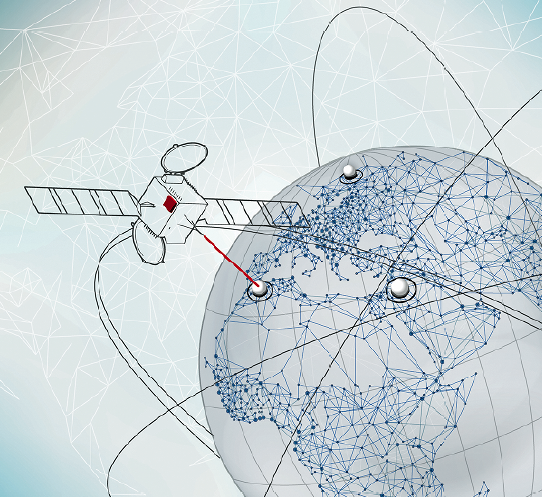Space-based optical communication systems are poised to take a breakthrough role in commercial smallsat missions.

Space-to-ground transmission through BridgeSat’s optical communications network provides large amounts of data delivery for satellite operators. Image is courtesy of BridgeSat.
Backed by successful on-orbit demonstrations, and led by new technology developments, the migration to optical communications from traditional radio frequency (RF) designs will provide a significant leap in the data downlink capabilities of low Earth orbit (LEO) small satellites.
Even today, LEO Earth observation smallsats generate more data than can be downlinked due to power limitations, a general paucity of available (RF) spectrum, variable pass durations and limited access to ground stations. Currently, approximately 27 percent of these smallsats generate more data than they are able to downlink, according to a recent study by Northern Sky Research (NSR).
That percentage will only widen as the number of smallsats in LEO increases, and the payloads create greater amounts of data from more capable imagers, live video feeds, synthetic aperture radar, and hyperspectral imaging sensors. Over the next decade, the amount of data that will be cumulatively downlinked by small satellites is expected to reach 3.9 exabytes, also according to the NSR study. Traditional RF capabilities alone may struggle to handle this growth, so a new data transmission alternative is needed that provides greater bandwidth through a service that is fast, secure, and offers lower latency.
To meet this need, BridgeSat, Inc. is developing a commercial, optical communications downlink-as-a-service system. BridgeSat is a wholly owned subsidiary of Allied Minds, an innovative U.S. science and technology development and commercialization company based in Boston.
Providing An Optical Communications Turnkey Solution
BridgeSat’s mission is to speed the adoption of optical communications systems by providing operators with a full turnkey solution that seamlessly connects satellites and high-altitude unmanned vehicles to the ground, and accommodates accelerating demand for accurate and frequent data collection from LEOs.
Designed to either augment existing RF systems or provide a primary downlink channel, BridgeSat’s solution includes mission analysis, upfront design work, delivery and integration of space terminals, and access to a ground network that provides delivery of the operator’s data directly from their satellite or UAV to their server.
The system is designed to also overcome the two main impediments that had historically challenged satellite-to-ground optical communications: the requirement for precise beam steering and the attenuation caused by cloud cover. Ground station site diversity is essential for optical communications to be a viable operational system. BridgeSat plans to establish a worldwide network of stations for spacecraft operators to use, regardless of their choice for the space optical terminal.
The BridgeSat solution emerged from research at The Aerospace Corporation (Aerospace) that focused on developing a small optical communications terminal for the NASA OCSD mission. Aerospace approached optical communications as an enabler to provide high data rate transmission that would fit on a 1.5U cubesat for the OCSD mission.
This strategy echoed the approach taken by multiple research agencies, universities and photonics labs across the world in optical communications, and has helped to establish a foundation for the potential mass adoption by commercial smallsat operators.
Optical communications systems offer certain advantages over traditional RF communications, including:
• High communications data rates: Traditional RF systems often offer much less than 1 Gbps data links. In comparison, today’s optical communications systems offer several Gbps downlink, with clear technology paths for future expansion
• Small size: Newly developed optical communications satellite terminals are available at less than 1 kg, with a form factor that fits within a 1U CubeSat standard volume
• Low power consumption: Newly developed optical communications satellite terminals can consume less than 20W, which compares favorably with RF hardware
• Secure data links: Optical communications links are more robust in contested environments against interception, interference and jamming

Bolstered by the additional collaborations of other leaders in communications, including Draper, the BridgeSat solution aims to mirror many of these benefits by offering:
• High data throughput with low latency: The data downlink rate is currently designed for up to 2.5Gbps, with an increase to 10Gbps planned for the future
• Small form factor: Seamlessly fits satellites of all sizes, making it easy to implement
• Cost effective: Lower $/bit than equivalent radio-frequency (RF) systems
• Customized service: Upfront design of an optical communications system that is matched to each customer’s specific requirements and satellite platform
• Greater security: Optical communications is inherently more secure
Long Heritage
The Aerospace Corporation is one of several organizations that have a long history of developing space-based optical communications. Until now, these systems had been largely limited to on-orbit technology demonstrations by the likes of NASA, the National Institute of Information and Communications Technology (NICT), the European Space Agency (ESA), Japan Aerospace Exploration Agency (JAXA), the German Aerospace Centre DLR and NASA Jet Propulsion Laboratory (JPL).
Some programs of significance include:
Launched August 1994, the NICT Engineering Test Satellite VI (ETS-VI) Experiments demonstrated 1 Mbps bi-directional optical links to the NICT optical ground station
Launched May 21, 2001, the Geosynchronous Lightweight Technology Experiment (GeoLITE) demonstrated high rate optical communication links at both LEO and GEO altitudes
Launched July 12, 2001, ESA’s Advanced Relay and TEchnology MISsion (Artemis) demonstrated an optical inter-satellite link with the French space agency CNES’s Earth observation satellite, SPOT 4, and an aircraft
Launched August 2005, the JAXA Optical Inter-Orbit Communications Engineering Test Satellite (OICETS, also known as Kirari) demonstrated both inter-satellite link and satellite-to-ground downlink
Launched in 2007, the Near Field Infrared Experiment (NFIRE) satellite carried a laser communication terminal developed by Tesat-Spacecom. This terminal was used for LEO-to-ground optical communication tests at up to 5.6Gb/s, and for optical crosslink tests with the TerraSAR-X satellite
Launched September 6, 2013, the Lunar Laser Communication Demonstration (LLCD) demonstrated successful 622 Mbps downlinks from the Lunar Atmosphere Dust and Environment Explorer (LADEE) spacecraft in a lunar orbit, to NASA’s Lunar Lasercom Ground Terminal (LLGT), JPL’s Optical Communications Telescope Laboratory (OCTL), and ESA’s Optical Ground Station (OGS)
Launched April 18, 2014, the Optical Payload for Lasercomm Science (OPALS) demonstrated 50 Mbps downlink from the International Space Station (ISS).
Even more ambitious optical communications systems are under development, including the ESA European Data Relay System (EDRS) and NASA Laser Communications Relay Demonstration (LCRD). While these agency systems will grow the state-of-the-art in optical communications in the long term, the formation of BridgeSat illustrates the nearer-term commercialization opportunity of optical communications technology.
Space-based optical communications systems are poised to make a breakthrough in commercial smallsat missions, and the timing is ideal for mass adoption by operators. Not only is the technology being thoroughly demonstrated in space, but it is based on well-established, commercial terrestrial optical communications technology.
Much like fiber optic cables provide the large point-to-point data pipes in terrestrial applications, optical communications has the potential to provide similar value to customers in the smallsat arena.

For smallsat operators looking to download large amounts of data from their satellites, optical communications offers the best solution, and BridgeSat stands ready to help enable this new market.
David Mitlyng is the Senior Vice President of Business Development and Strategy at BridgeSat Inc., an Allied Minds company dedicated to commercializing space-based optical communications. David more than 20 years of commercial satellite experience from SSL, Orbital Sciences, and Hughes Space and Communications. He has a MBA from the MIT Sloan School of Management (15-15), MS in Aeronautics and Astronautics from Stanford University, and BS in Aeronautical Engineering from California Polytechnic State University, San Luis Obispo, California.



